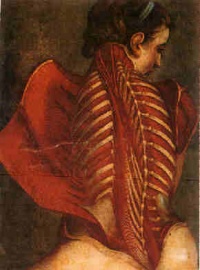Marine
From The Art and Popular Culture Encyclopedia


|
Related e |
|
Featured: |
- This article discusses the technique of engraving for printmaking, one of the earliest techniques in the democratization of visual culture.
In the European Middle Ages goldsmiths used engraving to decorate and inscribe metalwork. It is thought that they began to print impressions of their designs to record them. From this grew the engraving of copper printing plates to produce artistic images on paper, known as old master prints in Germany in the 1430s. Italy soon followed. Many early engravers came from a goldsmithing background and the new technique largely replaced woodblock printing. The first and greatest period of the engraving was from about 1470 to 1530, with such masters as Martin Schongauer and Albrecht Dürer.
Thereafter engraving tended to lose ground to etching, which was a much easier technique for the artist to learn. But many prints combined the two techniques - although Rembrandt's prints are generally all called etchings for convenience, many of them have some burin or drypoint work, and some have nothing else. By the nineteenth century, most engraving was for commercial illustration.
Before the advent of photography, engraving was used to reproduce other forms of art, for example paintings. Engravings continued to be common in newspapers and many books into the early 20th century, as they were long cheaper to use in printing than photographic images. Engraving has also always been used as a method of original artistic expression.
Traditionally, engravers created darker areas by making an area of many very thin parallel lines (called hatching). When two sets of parallel line hatchings intersected each other for higher density, the resultant pattern was known as crosshatching. Claude Mellan is well-known for his technique of using parallel lines of varying thickness. One notable example is his Sudarium of Saint Veronica (1649), an engraving of the face of Jesus from a single spiralling line that starts at the tip Jesus's nose.
Noted engravers
Prints (see also List of Printmakers):
- Jacopo de' Barbari (active 1500-1515)
- Theodore de Bry (1528-1598)
- William Blake (1757-1827)
- Giulio Campagnola (active c.1505-1515)
- Gustave Doré (1832–1883)
- Albrecht Dürer (1471–1528)
- Master ES (active c.1450-1470)
- Maso Finiguerra (1426-1464)
- Hendrick Goltzius (c.1558-1617)
- Francisco de Goya (1746-1828)
- Stanley William Hayter (1901-1988)
- William Hogarth (1697–1764)
- Helen Hyde (1868-1919)
- Lucas van Leyden (1494-1533)
- Andrea Mantegna (c.1431-1506)
- Claude Mellan (1598-1688)
- Israhel van Meckenem (c.1445-1501)
- Matthäus Merian (1593-1650)
- José Guadalupe Posada (1852-1913)
- Jan Saenredam (1565-1607)
- Martin Schöngauer (c.1450-1491)
- John Sturt (1658-1730)
- Maerten de Vos (1532-1603)
- Anthonie Wierix (1552-1624)
- Hieronymus Wierix (1553-1619)
Of gems:
- Theodorus of Samos,Polycrates' gem-engraver
- Pyrgoteles, Alexander's gem-engraver
Of guns:
- A. B. Bradshaw (Firearm Engraver)
- Thierry Duguet
- Geoffroy Gournet
- Ken Hunt (engraver)
- Harry Kell
- Harry Morris (sometimes Henry Morris)
- Jack Sumner
- Sam Alfano
Of coins:
Of postage stamps:

